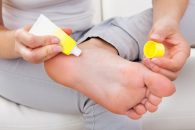Practicing proper foot care for diabetics is so important – here are the facts.
Anyone who has diabetes should know about diabetic foot care. Diabetes can affect the feet in many ways, and can cause devastating health consequences. To assist you in avoiding serious problems, we will discuss some of the facts about foot care for diabetics and why it is so important to take care of your feet:
What are the early signs of diabetes? Click here to learn more.
Why Diabetic Foot Care is so Important
Nerve damage (neuropathy) in the legs and feet can be brought on by diabetes, and cause narrowing of blood vessels that lessen the flow of blood to the feet. Some common symptoms of nerve damage include:
- Tingling in the legs and feet
- Numbness, weakness
- Stabbing pains
- Shocking sensations
- Twitching
- Atrophy
- Sensitivity and burning sensations
- Paralysis
Nerve damage sensitivity in the legs and feet can cause a variety of symptoms including: insensitivity to touch, pain and temperature, and also the loss of balance. Reduced blood flow can make it more difficult for the body to heal, slowing down the process of healing sores, ulcers, cuts, and bruises, that can lead to infections. Infections in the feet that are not healed, can put the diabetic at risk for amputation of a toe, foot or leg.
Diabetes Foot Care
It is vital that diabetics learn how to properly care for their feet to avoid serous consequences. Our guide to proper diabetic foot care should give you a solid foundation of helpful information about maintaining good foot health:
- The first step of healthy foot care for diabetics begins with a daily inspection of your feet. Look for wounds, cuts, sores, blisters, swelling, and nail problems. You can use a hand mirror with magnification to carefully inspect the back of your feet. If you discover any problems with your feet, you should contact your doctor.
- If you have corns or calluses, do not attempt to treat it yourself with over-the-counter treatments, but instead visit your doctor for appropriate treatment.
- Wash your feet daily with soap and lukewarm water, and never use hot water. Use a soft washcloth or sponge for washing, and then pat your feet dry with a soft towel making sure to dry between the toes too.
- The next step in proper diabetes foot care is to moisturize your feet with a good skin cream to avoid dry skin, itching and cracking. It is recommended that you not moisturize between the toes to avoid getting fungal infections.
- Make sure that your toenails are trimmed straight across and the edges are filed smooth. Avoid cutting your toenails too short or cutting into the sides of the nail, which can cause ingrown toenails.
- Good foot care for diabetics includes a daily change of clean, dry socks for your feet. You may want to invest in socks that are made specifically for diabetics. These types of socks have extra cushioning and are made using fibers that keep moisture away from your skin. If you find that your feet get cold at night, wear socks, but never opt for a hot water bottle or heating pad.
- Keep your feet warm and dry in inclement weather, using protective footwear when necessary.
- Good diabetes foot care advice is to never walk around barefoot and take the chance of stepping on something that can cause a cut or scratch. Always wear your shoes or a pair of slippers.
- Especially for those who have lost feeling in their feet, it is always a good idea to feel the inside of your shoes, and shake them out before putting them on. This practice can hep to avoid injury from a pebble or other foreign object.
Good foot care for diabetics also means getting regular foot check-ups from your doctor. With your doctor’s assistance, and daily diabetic foot care practices, you can keep your feet in good health. Learn more tips for your feet at www.BetterHealthKare.com



